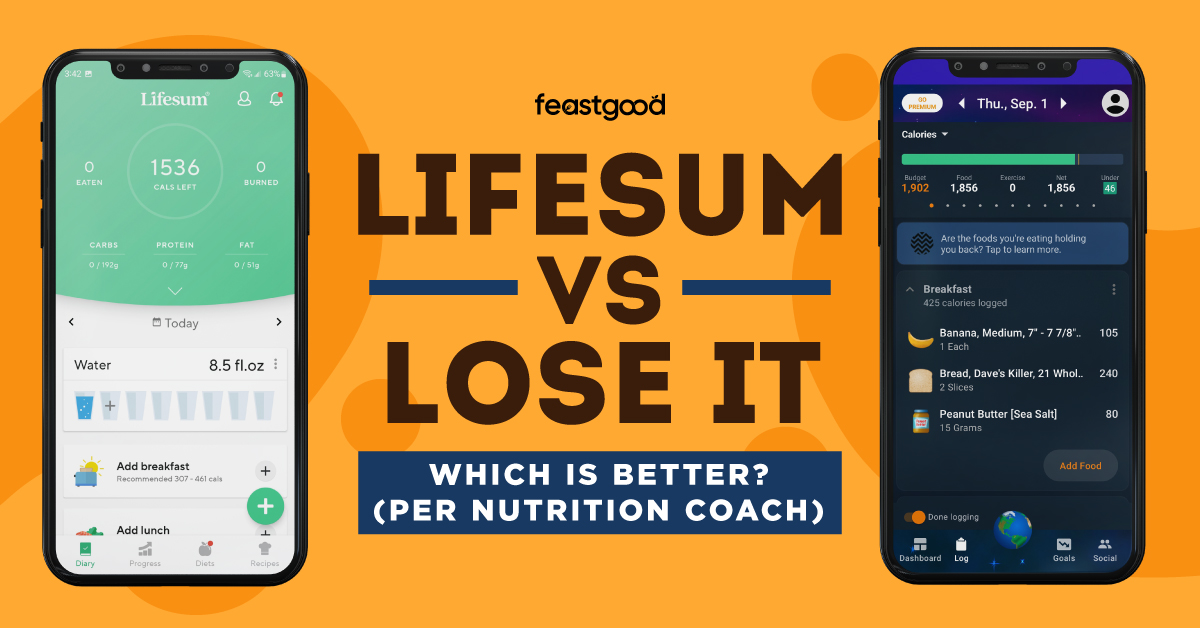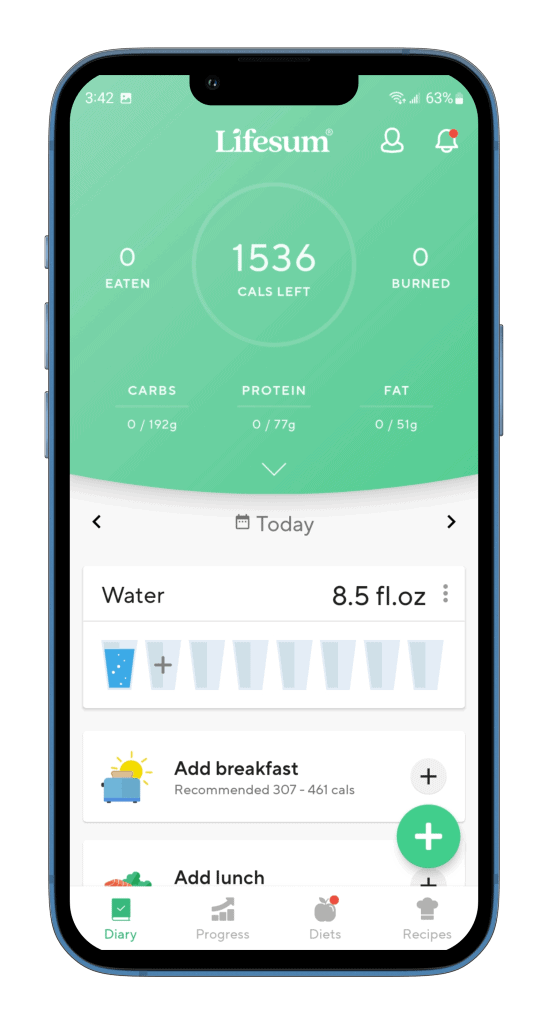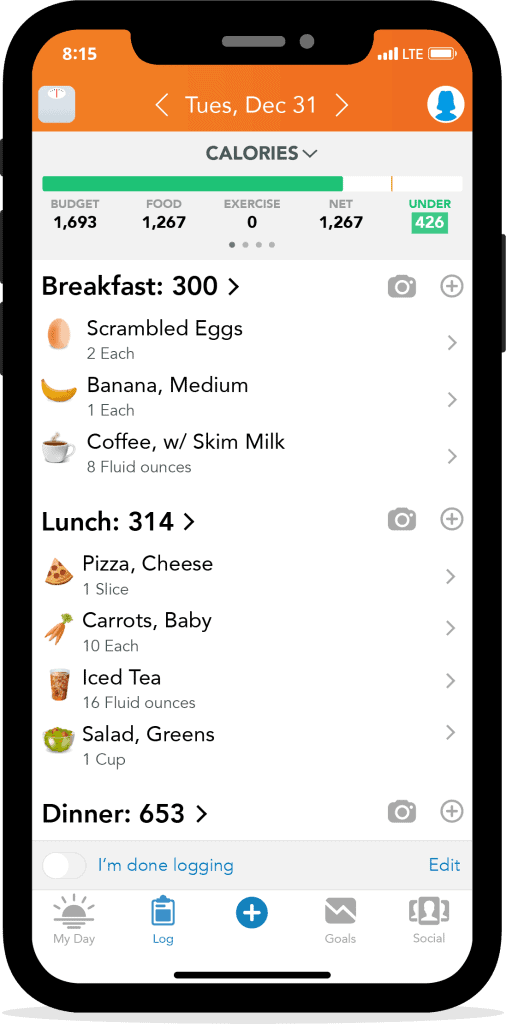Some links in this article are affiliate links, which means we earn from qualifying purchases. Learn more.
After using both Lifesum and Lose It for one month each, I’m now in a great position to comment on the pros and cons of each nutrition app and advise on which one is better for specific goals.
Key Takeaways
Honest Review Guarantee from FeastGood: Our testing team purchases each product 100% independently and uses the product for several weeks up to several months before writing a review. Learn more about our review process here.
- The main difference between Lifesum and Lose It is that Lose It solely focuses on weight loss. In contrast, Lifesum can be used for various goals, including fat loss, health, performance, and body recomposition.
- Lose It takes a calorie-focused approach to weight loss, which reduces the sense of overwhelm from trying to track macros and calories.
- Lifesum focuses on calories, macronutrients, and habit change to help users achieve their goals. It is also an excellent app for learning more about the nutritional value and quality of different foods.
- In our head-to-head comparison across ten criteria, Lifesum won in four categories, and Lose It won in two—the apps are tied in the four remaining categories. So, while the match-up wasn’t a complete domination by Lifesum, it’s still the better pick for most people.
Medical Disclaimer: The content of this article is provided for educational insights only. It should not be used as medical guidance. Individuals with a past of disordered eating should refrain from weight loss programs or calorie tracking. For medical advice, consult a certified healthcare professional. If you’re struggling with eating disorders, contact NEDA for assistance.

What Is Lifesum?
Lifesum is a nutrition app that tracks both calories and macronutrients. It can help users with various goals, including health, performance, weight loss, weight gain, or weight maintenance.
Lifesum also allows users to track exercise and set goals for healthy habits, enabling users to focus on improving health and not just strictly on losing weight. Users can even set weight gain goals, though this is less common.
Lifesum stands out amongst other nutrition tracking apps because of its extensive recipe database and meal plans, which appeal to those who want more nutritional guidance on what to eat.
While Lifesum’s calorie/macro recommendations are generally too low for highly active and/or muscular individuals (based on my testing), users can adjust these recommendations by setting custom targets.
The downside? You need at least some nutritional knowledge to be able to customize your own calorie/macro targets.
For more details, read my complete Lifesum Review.
Pros
- Calorie and macro targets are customizable
- The database of foods is verified
- The database of recipes is extensive and inspiring
- Ability to set habit goals
Cons
- Calorie recommendations are too low for highly active and/or muscular individuals
- Some of the pre-loaded meal plans are too restrictive
Lifesum
An excellent app to track both calories & macros. With an extensive meal plan and recipe database, it can help users accomplish a range of health and fitness goals.
This link gets you 50% off the annual plan. No code is required
What Is Lose It?
Lose It is a weight loss-focused nutrition app that prioritizes calorie counting. Based on user intake information about their lifestyle and goals, it provides a calorie target for users to strive for when tracking their food intake using its extensive food database.
Lose Its focus on calories is suitable for people who are new to tracking their intake or finding that trying to hit macronutrient targets is overwhelming. Additionally, its calorie recommendations seem more accurate for active individuals than Lifesum’s.
However, the same cannot be said for its macronutrient recommendations (which are essential to improving body composition and/or performance).
Lose It allows you to track macronutrients (protein, carbs, and fat), but it is more of an afterthought, which is evident as its macronutrient suggestions don’t necessarily align with the calorie targets and generally set protein targets too low for active people.
As is, Lose It is not suitable for those wanting to improve their health, performance, or body composition. However, Lose It is a great app to use when working with a nutrition coach who can recommend macronutrient targets that align with your calorie target.
In the premium version, you can customize your targets based on advice from your coach, and the app can send daily or weekly nutrition reports to your coach.
A final perk of Lose It is a social network built into the app where you can communicate with other users for support, advice, and encouragement. Plus, you can earn badges, which is a fun source of motivation to stay on track with your goals.
For more details, read my complete Lose It App review.
Pros
- Calorie and macro targets are customizable
- Offers a built-in community for support
- Badges create a sense of fun and motivation
Cons
- Macronutrient recommendations are inaccurate
- Many features are only available in the paid version
- Membership options are limited to annual or lifetime
Lose It App
Lose It is best for those who want to focus primarily on calorie counting because its design focuses more on caloric intake than macronutrient intake. It’s an excellent option for those seeking changes in body weight.
Lifesum vs. Lose It: Head To Head Comparison
To determine which nutrition app best suits your needs, see how the two compare in the following ten categories:
1. Food Categorization
Lifesum
Lifesum provides ratings for each food based on its nutritional information. The app states the benefits and drawbacks of the food, serving as a great educational feature for users to better understand which foods can promote better health and why.
Lose It
Lose It does not provide any rating for its food.
The Winner: Lifesum
Lifesum’s food ratings are a great educational tool, empowering users to maintain their weight loss and make better food choices for their health rather than focusing solely on calorie count.2. Tracking Capabilities
Lifesum
Lifesum allows users to track calories, macronutrients, water intake, exercise, habits, body weight, and measurements.
With this many inputs (calories, macros, water, activity, and habits) compared to outputs (weight and measurements), it can be easier to see how your behaviors add up to your results (or lack thereof).
Lose It
Lose It allows users to track calories, macronutrients, and certain micronutrients and sync exercise/activities from other devices.
Users can compare this data to body fat percentage, circumference measurements, blood pressure, and blood glucose measurements the app records to gauge progress.
However, it is worth noting that most of the advanced tracking capabilities in Lose It are only available in the premium version.
The Winner: Lose It
Lose It’s detailed health metrics put it slightly ahead of Lifesum. In both cases, a premium version of the app is required to track all the metrics listed above.3. Calorie Recommendations
For reference, a healthy and sustainable rate of fat loss is generally 0.5-2 lbs per week for most people or no more than 1-2% of body weight (meaning it’s okay to have a higher rate of loss if your starting weight is higher).
This rate of loss equates to no more than a 15-20% reduction in calories needed to maintain weight.
For example, if you maintain your weight at 2200 calories, then aim for an intake of no less than 1760-1870 calories.
Lifesum
Lifesum’s targets might be appropriate for sedentary people. Still, the staff here at FeastGood.com (myself and other certified coaches and athletes) agree that the calorie recommendations are way too low for active individuals.
Low-calorie targets also mean lower macronutrient targets, especially protein, significantly increasing the risk of losing muscle mass and slowing metabolism.
Lose It
Lose It’s calorie target recommendations consider activity levels (part of the intake process), generally resulting in more accurate targets than Lifesum. However, its macronutrient targets, particularly protein, are just as inaccurate despite the calorie target being more reasonable.
Therefore, users will still be at risk for muscle loss and its impact on metabolism unless these targets are customized.
The Winner: Lose It
Lose It does an excellent job of providing an appropriate calorie deficit below TDEE (your total daily energy expenditure to maintain your weight) for sustainable weight loss.However, you must adjust the macronutrient targets it provides to improve your health, performance, or body composition.
Lifesum’s calorie (and therefore macronutrient) recommendations are too low for sustainable weight loss; therefore, you must adjust both recommendations (calories & macros).
4. Level of Customization
Lifesum
You can set your own calorie and macronutrients targets in Lifesum. Plus, you can set healthy habit goals and choose to follow a meal plan if you prefer to follow a plan.
Lose It
Lose It’s premium version allows you to customize your calories, macronutrients, and even certain micronutrients like sodium or cholesterol. You can also set different targets for different days of the week, such as high-carb and low-carb days for carb cycling.
The issue is that Lose It doesn’t provide much guidance in setting your calorie and macronutrient targets, and the macronutrient targets won’t necessarily add up to the calorie targets unless you know what you are doing.
The Winner: Tie
The fact that you can set different targets for different days in Lose It gives it an edge, but only for those working with a coach or highly knowledgeable themselves.Lifesum’s “healthy habits” and meal plan features make it about more than just weight and give the average person with no prior knowledge of nutrition something to customize. So, this category is a tie.
5. Coaching
Lifesum
There is no coaching feature in Lifesum.
The meal plans and recipes inside the app are meant to be a “self-guided” system so that you can coach yourself toward your fitness goal.
Lose It
There is no coaching feature in Lose It.
However, if you have a nutrition coach who wants to monitor your nutritional intake, Lose It can provide this information efficiently to your coach.
There is also a community of other members within the app that you can engage with. While this isn’t a coaching feature, it does have some accountability as part of a social group working toward similar goals.
The Winner: Tie
Neither Lifesum nor Lose It has a coaching feature. Our number #1 rated app for weight loss coaching is Noom (check out our full review).6. Food Database
Lifesum
Lifesum’s extensive food database includes entries from 5 different lab-analyzed food databases (such as the Nutrition Coordinating Center Food & Nutrient Database (NCCDB) and the United States Department of Agriculture National Nutrient Database for Standard Reference (USDA).
However, Lifesum also has foods that have been input by users, meaning that they are subject to error.
The best bet is to stick to verified food choices (the ones with checkmarks) to ensure accuracy.
Lose It
Lose It’s database includes both verified and unverified foods for a whopping 34 million entries. But instead of third-party lab-verified foods from independent databases (like Lifesum), the verified foods in Lose It are only verified by the Lose It team, meaning the information may not be as accurate.
The Winner: Lifesum
Lifesum’s verified foods from lab-analyzed food databases increase the likelihood of accurate tracking, making it the winner for food databases.7. Recipe Database
Lifesum
Lifesum’s recipe database is top-notch. Each recipe includes detailed nutritional information about macro- and micronutrients, so you can track your meals easily and know you’re making good choices for your health.
Lose It
Lose It does not have a recipe database, which is a significant disadvantage compared to Lifesum.
The Winner: Lifesum
Lifesum is the winner with its extensive recipe database of delicious, nutritious, and inspiring meal and snack ideas. Its recipe database is one of its key features to help users stay on track with their targets by giving them appealing and healthy recipes.8. Exercise Calories
Exercise calories can be a confusing subject for many people. Most nutrition apps will estimate calories burned during exercise, whether the activity is synced from another tracker or input manually in the nutrition app.
Then, many apps will automatically add these estimated exercise calories to your daily calorie target. But this makes weight loss more challenging because the calories you burn through exercise aren’t helping you achieve a calorie deficit (which is required for weight loss).
Your daily calorie target should already consider your average activity level (including exercise), so it’s better to set the app not to add calories burned from exercise to your calorie target.
I’ll discuss what each app does with exercise calories:
Lifesum
The default setting is for Lifesum to add back all calories burned through activity, which can be frustrating if your goal is to create a calorie deficit to lose weight by exercising.
The good news is that you can turn the feature off so that calories burned are not added to the daily total.
Lose It
Lose It’s default settings also add all the calories you burned from activity to your daily calorie total, but it provides users with the option to “exclude from total calories” each time they log their activity.
The Winner: Tie
Since you can choose whether or not to include activity calories in either app, I’m declaring this a tie.9. Price
Lifesum
Lifesum is competitively priced at $49.99 USD per year or $9.99/month. The monthly option is an excellent choice for someone who wants to try it out or has a goal with a short time frame.
Lose It
The premium version of Lose It is definitely the way to go because the most helpful features are only available in this version (for example, the ability to customize macronutrient targets, or log body measurements).
Unfortunately, Lose It does not have a free trial or monthly membership to try for a few months before committing. The only choices are annual or lifetime at $39.99/year or $189.99/lifetime.
However, the monthly rates are very reasonable at these prices, especially if you use the app for several years. With a lifetime membership, you could use it off and on for periods of several years, as needed, for various goals.
The Winner: Lifesum
Even though Lifesum costs more per year than Lose It, the flexibility of a monthly membership option makes it the winner in this category. Most people don’t want (and don’t need) to track their food for years to achieve and maintain their health and fitness goals.10. Reviews
Lifesum
Lifesum has 4.5/5 stars from nearly 320k reviews. Users are pleased with their weight loss results, at least in the short term.
Lose It
Lose It also has a rating of 4.5/5 stars based on fewer reviews (~127k). Positive reviews are related to people losing weight; negative reviews have to do more with technology issues (glitches) with the app vs. saying that the app doesn’t work for weight loss.
The Winner: Tie
Lifesum and Lose It are rated 4.5 out of 5 stars, so they are tied for this category.Other Diet App Comparisons:
About The Author

Lauren Graham is a Precision Nutrition Level 1 certified nutrition coach. She focuses on helping busy professionals balance healthy eating and purposeful movement. Lauren has a background in competitive swimming and is currently competing as a CrossFit athlete. She has a passion for training, teaching, and writing.
Why Trust Our Content

On Staff at FeastGood.com, we have Registered Dietitians, coaches with PhDs in Human Nutrition, and internationally ranked athletes who contribute to our editorial process. This includes research, writing, editing, fact-checking, and product testing/reviews. At a bare minimum, all authors must be certified nutrition coaches by either the National Academy of Sports Medicine, International Sport Sciences Association, or Precision Nutrition. Learn more about our team here.
Have a Question?
If you have any questions or feedback about what you’ve read, you can reach out to us at [email protected]. We respond to every email within 1 business day.




